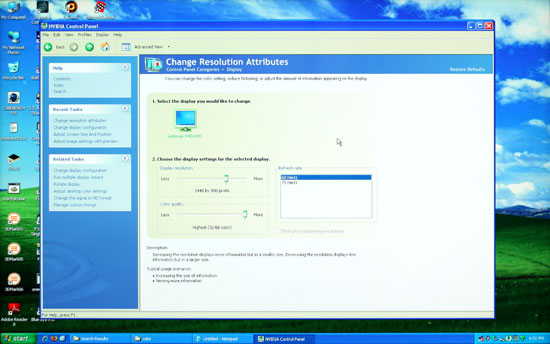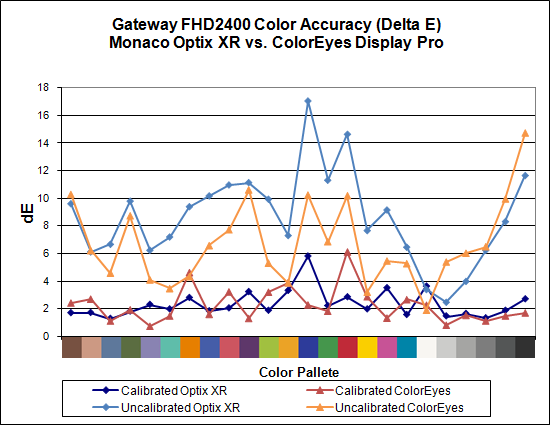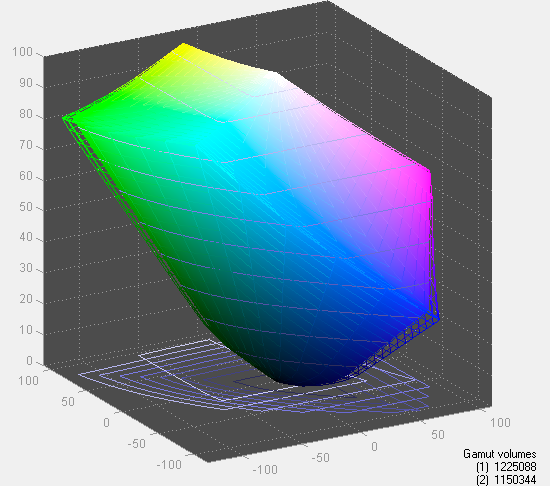Gateway FHD2400 Evaluation
The Gateway OSD remains largely unchanged since last Gateway LCD we reviewed -- the Gateway FPD2485W. It worked well over a year ago and it continues to work well today. Gateway uses a touch-sensitive buttons system on the right side of the LCD, but rather than leaving you to guess where to press, all of the active buttons light up as soon as you press the menu button. Our only complaint is that there are areas where Gateway could make better use of the buttons.
As an example, when you first activate the menu there are six buttons plus an additional two buttons up top that cycle through the color presets. These six buttons allow you to jump directly to one of several areas. Once you enter the Main menu, however, you then have to use the top two buttons to move up and down with the third button functioning as a select key. Granted, there are eight options in the main menu, but two of these (Auto and Reset) could easily be moved to a submenu. As a whole, though, this is a minor complaint on an OSD setup that works well.
Gateway includes seven color presets, one of which is "User" and allows manual adjustment of the color levels. Gateway also includes support for RGB and YUV color spaces. Also of interest is the "UltraResponse" function that supposedly improves pixel response times -- not that we could really tell. Gateway claims 3ms with UltraResponse enabled versus 5ms without UltraResponse.
The FHD2400 has four aspect ratio options: Wide, Zoom, 1:1, and Panoramic. "Panoramic" scaling only shows up with component (and perhaps other analog video connections), but then it just seems to do the same thing as "Wide". "Wide" fills the entire LCD with your current resolution, while "Zoom" fills the height or width while maintaining the correct aspect ratio. "1:1" is again a direct-mapped mode without any stretching. Here's a summary of our resolution testing:
| Gateway FHD2400 Resolution and Input Notes | ||||
| Component | DVI | HDMI | VGA | |
| 800x600 | Yes | Yes | Yes | |
| 1024x768 | Yes | Yes | Yes | |
| 1152x864 | Yes | Yes | Yes | |
| 1176x664 | Underscanned 720P | - | Underscanned 720P | - |
| 1280x720 | Yes | Yes | Yes | Yes |
| 1280x768 | Yes | Wrong AR (1280x1024) Use "Zoom" scaling |
Yes | |
| 1280x800 | - | Wrong AR (1280x1024) Use "Zoom" scaling |
- | |
| 1280x960 | Yes | Yes | Yes | |
| 1280x1024 | Yes | Yes | Yes | |
| 1400x1050 | - | Yes | - | |
| 1440x900 | Yes | Yes | Yes | |
| 1600x1200 | Yes | Wrong AR Always fills LCD ("Zoom") |
Yes | |
| 1680x1050 | Yes | Yes | Yes | |
| 1768x992 | Underscanned 1080i | - | Underscanned 1080P | - |
| 1920x1080 | Too much flicker | Yes | Yes | Yes |
| 1920x1200 | - | Yes | Yes | Yes |
First, let's get this out of the way: the component connection is only really suitable for 720P or 1080i signals. In general, the 720P option looks much better -- the opposite of the 2408WFP when using a component connection. All resolutions with more than 720 scanlines show severe flicker on component, as they run 60Hz interlaced. The other tested input options all work much better. VGA and DVI achieve a perfect score on all of the available resolutions, with no scaling abnormalities. Also worth mentioning is that the "Auto adjust" function on VGA is very fast. HDMI input has a few errors that you can work around by manually selecting "Wide" scaling; only 1600x1200 as an uncorrectable error in that it always fills the entire LCD, regardless of what scaling mode you choose.
 |
Running at non-native resolution, the FHD2400 does well at scaling the image to fit the panel and there are no serious artifacts. Obviously, 1920x1200 is still the optimal setting, but if you need to play a game or watch a movie at a lower resolution, you shouldn't have any complaints.


Besides limited viewing angles -- which are a problem on all TN panels today -- the one sticking point with the Gateway FHD2400 is color accuracy. After calibration, it achieves an average Delta E of only 2.3, which puts it in last place among tested LCDs. Uncalibrated color accuracy is also quite poor, coming in at 8.6 with plenty of colors above 10.0. Imaging professionals will almost certainly want something better. The good news is that the color gamut is good, achieving over 95% of the Adobe RGB 1998 standard.
The Gateway FHD2400 is sort of the opposite of the Dell 2408WFP. The Dell offers the absolute worst input lag but has by far and away the best color accuracy. The FHD2400 doesn't suffer from input lag at all, but unfortunately it has some of the worst color accuracy among tested LCDs. It's still a beautiful looking LCD, and it gets so many things right that we have no qualms recommending it to non-imaging professionals. That goes double if you'd like glossy LCD panels.
















89 Comments
View All Comments
Bolas - Friday, July 31, 2009 - link
Anand,Any chance of a 30" monitor roundup for those of us wanting to buy an extreme HD monitor to go along with the new high end gaming computer we're buying around Christmas time?
I'm not sure which is best between the stuff currently on the market (or things coming out in the near future, say by Christmas). I've heard of:
Dell 3007WFP
Dell 3008WFP
HP LP3065
Gateway XHD3000
Samsung Synchmaster 305T
Apple Cinema 30"
Am I missing any 30" monitors currently available? Which is the best, regardless of price? Which is the best in terms of bang-for-the-buck? Which is "future-proof", with good connectivity? I plan to use it to play Starcraft II and Warcraft III and maybe some Everqeust.
I just turned 40, so as part of my mid-life crisis, I'm buying a high end gaming computer, probably a CyberPower Black Mamba or a Digital Storm of some kind, depending on how the stock market does.
Basically an overclocked Core i7 with three-way or quad SLI. My computer budget is $4000 to $6000, not including monitor price, and I can get a nicely configured Cyberpower for about $5400 last I checked. But what to use to display all that computer goodness? I figure to spend $1000 to $2000 on a 30" monitor, but which one?!?
Thanks!
-Bolas
szore - Tuesday, June 23, 2009 - link
I bought this for about $269 free tax and shipping and I love it for gaming.jpp - Monday, September 15, 2008 - link
Hi,First of all a big thank you for these reviews - they are top notch.
I'm currently trying to decise between the Samsung and the Dell. I'm not into gaming, so latency doesn't bother me. Nor for that matter do the plethora of inputs both provide - I'll just be using with the one DVI input at native resolution.
Living in PAL country, I would be delighted if either of these monitors do 50Hz FR. I doubt it very much, but thought it worth asking. I know that my large Samsung 405T wasn't specified at 50Hz, but it is able to do it natively nevertheless which makes for judder free PAL DVD and FTA TV program watching on the screen.
So, apart from this probably undefined/untested aspect, which would be the better choice, given as I say that I am not interested in gaming?
I bring this comparison up here as this review does not list the Samsung in its comparison table. The Dell was the editor's choice, but the Samsung was reviewed after this 24in line up, so I was wondering if it could be included somewhere in the ranking?
Thansk again for the tremendous effort that goes into the testing and reporting.
Phil.
jpp - Monday, September 15, 2008 - link
As I can't edit my previous post, just a correction wrt the timing of the 2 reviews.The Samsung review was done before the 24in panel review, yet it's not listed in this review. That seems a bit odd and I was wondering why that is the case?
billingsgate - Monday, May 26, 2008 - link
I can't find reviews anywhere of Eizo LCD monitors. Eizo has a great reputation, but that's all I seem to be able to go on. A salesman gave me a really good pitch for the Eizo FlexScan S2401W. It's a Samsung TN panel (he claims), but somehow being an Eizo it's much better for color quality than any Samsung in the price range. It seems to be a good candidate for balancing accurate color and minimum input lag. But I can't be sure, since I can't test it in the shop for any of those things, plus the shops where I live are all little cubby holes in computer centers, with minimum choice in each shop, so it's impossible to do any side-by-side comparisons between Eizo, Samsung, NEC, etc., since they're never together in the same place.Any thoughts on Eizo's (relatively) budget line of FlexScans?
silvajp - Sunday, May 25, 2008 - link
Today I bought a Samsung 2693HM for $600 - $50 rebate and I am blown away. It looks great - very bright and vibrant. I am wondering if it has the same low input lag as the 2493HM. The resolution is 1920x1200 so at 25.5" it's got bigger pixels which is just fine for my poor tired eyes.billingsgate - Thursday, May 15, 2008 - link
Can someone help me with a recommendation? After reading billions of reviews of monitors I am confused as hell? is there a "best compromise" LCD monitor for both color accuracy and least lag time?I am not a gamer. I am an animation professional, and I heavily use Wacom tablets for drawing, loose and freehand, with Photoshop, Flash, and various professional animation programs. I've always used a CRT monitor and never once have experienced any lag between my stylus movement and lines on screen. I do own a Compaq tablet PC, and when I draw on-screen, the lag is perceptible enough to make the drawing very unnatural and inhibited. I just can't draw freehand that way.
As my beloved, expensive flat screen Samsung CRT monitor is now dying after 7 years of heavy use, I'm in the market for an LCD. In my business I need both excellent color accuracy and zero or minimal lag time for stylus input. Where I live (Hong Kong) there isn't a single shop that would ever allow me to test such a setup, so it's a lottery for me. Plus, their in-store demonstrations for color "accuracy" are geared for Asian tastes, which is heavy HEAVY on oversaturated red (while westerners prefer oversaturated green).
After poring through all the reviews, particularly on this site, I can't even narrow down the choices to 4 or 5 candidates. The Dell 2408 looks amazing except for lag time. The Samsung XL20 (not widescreen, but I don't really care) looks great for color and no lag time, but it has a noisy fan (irritating!) and is a bit smaller than I want.
Can someone seriously help me to narrow the potential choices for something that has good or great color and minimal input lag? I won't ever use it for gaming or for TV or video viewing.
hjkelly - Thursday, May 15, 2008 - link
I'm in a similar spot - into editing photos and watching movies. I was almost set on the Dell 2408, but then I found out it has about four frames of lag, which wouldn't be fun for movies (or drawing with a Wacom tablet, I'm sure). I've finally settled on DoubleSight's DS-263N. If you want a quick summary, it's like an Apple Cinema display, but 26" and with a polarizer to get rid of the white haze at wider angles. It's also very fast, less than one frame's delay, I believe. It's around $700, but the catch is that it's hard to find in stock, so you'll have to be on your toes to get one. But isn't that just a sign of quality, really? =)JarredWalton - Friday, May 16, 2008 - link
Surely you know someone over there that can let you borrow an LCD to test out? Honestly, I don't think you'll experience problems with input lag - we're talking about 50ms or so relative to a CRT, so 1/20 of a second. What you've noticed on a tablet PC probably has a lot more to do with the lack of processing power and other differences. All you really need to do is find someone with an S-PVA 24" LCD and you can see if you notice lag. I can game fine on the 2408WFP - the lag is just barely perceptible at times, but not enough to cause me problems. But I'm not a competitive gamer.As for DoubleSight, their 26" LCD is about to be phased out apparently - I asked them for a review sample and they said it was at EOL. It may become even more difficult to find in stock shortly.
Anyway, I hear good things about a few MVA panels (that I haven't ever seen let alone tested), or if money isn't a serious concern just pick up something like the HP LP3065. For professional use, I have a hard time finding anything I would prefer to a nice S-IPS 30" LCD. And the 2560x1600 gaming resolution is nice as well.
billingsgate - Friday, May 16, 2008 - link
Actually, I don't know anyone with an LCD screen to borrow, other than my son's cheap one which is fine for gaming but not even close to being color accurate, so not exactly a good example. I can tell you that I tried a Wacom Cintiq tablet, which is essentially an LCD screen you can draw on. It was connected to a G5 Mac, so no lack of processing power. The lag on that was a fraction of a fraction of a second. But I kept finding my hand slowing down to let the line catch up to the stylus, which sucked all the spontaneity out of my drawing. In other words, for a "sensitive artist", even a small lag is noticeable. With the Cintiq I attribute it to the signal having to travel round trip on a USB connection. But I am now quite concerned about buying the wrong LCD and being stuck with it. This isn't the USA. Once you buy something and leave the shop, there is no such thing as returning it.So, to repeat my question: can you or someone help to recommend a shortlist of monitors that are both good to great for color accuracy, and minimal for input lag?